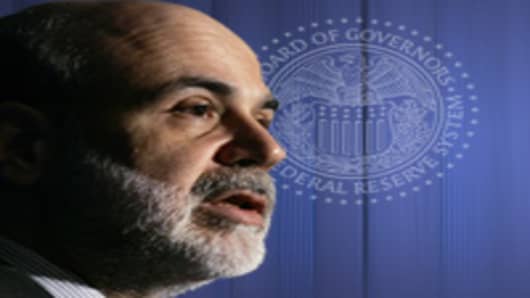Obviously, the Fed's stated goal with QE2 (quantitative easing) is to bring down interest rates.
And we think they have succeeded wildly up until now.
But is the Fed pressing it's luck with this latest round of asset purchases?
The markets seem to be saying just that.
While bond pricesrose (and yields fell) following the numerous hints from Fed officials that QE2 was imminent, the latest bond market action suggests that the buyers are running out of gas. It seems that several better-than-expected economic reports may be working against the Fed at this stage. Better employment, manufacturing, retail sales, confidence, and housing numbers may be telling us that more stimulus is not needed and may not be worth the risk. Investors seem to be increasingly worried about the longer-term inflationary implications of all the money that is being printed. As worries about inflation increase, investors are now selling longer-dated Treasury bonds, leading to an increase in yields - the opposite of what the Fed would like to see.
Is this just another blip, or has the tide turned?
The Fed continues to tell us that inflation and inflation expectations are under control. And indeed, the Fed's preferred metrics for gauging inflation continue to tell us just that. However, the Fed's printing presses have led to a 13% drop in the dollar against a basket of six currencies since early June.
The drop in the dollar is welcome by Fed and administration officials because it makes our exports more attractive in the international marketplace. However, the drop in the dollar is also creating a backlash against the US because it is threatening an export-led recovery in nations highly dependent on exports. Moreover, the drop in the dollar has also had profound implications for commodity prices. As the dollar has dropped, commodity prices across the spectrum have risen. Investors are buying commodities both because they are a hedge against inflation and because most commodities are traded in dollars (which have weakened significantly) in the international markets. The Chinese are getting especially worried about higher commodity prices and have recently raised reserve requirements at banks in an effort to stave off inflationary pressures. Will the drop in the dollar and corresponding rise in commodity prices eventually lead to more widespread inflationary pressures in the US as well?
The Fed seems to be walking a dangerous line.
It's efforts to lower interest rates have been very successful so far, but concerns are clearly rising about the longer-term implications of Fed action. We have long believed that housing is one of the keys to an economic recovery. Despite some promising housing sales data last month, we believe several factors may lead to further housing price declines in the future. If the Fed's QE2 program sparks inflationary fears and higher interest rates (and mortgage rates), the implications for housing could be severe. Moreover, higher interest rates will negatively affect the recovery across numerous others sectors of the economy.
So should the Fed call off the hounds for now? More and more, it's beginning to look that way.
Michael K. Farr is President and majority owner of investment management firm Farr, Miller & Washington, LLC in Washington, D.C. Mr. Farr is a Contributor for CNBC television, and he is quoted regularly in the Wall Street Journal, Businessweek, USA Today, and many other publications. He has been in the investment business for over twenty years.



